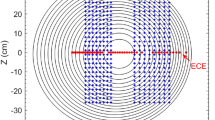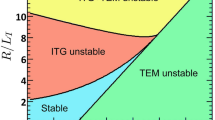Abstract
During the last several years, the HL-2A experiment has made significant progress in the following areas: (1) lower-hybrid wave (LHW) heating and current drive, (2) plasma confinement and turbulent transport, (3) magnetohydrodynamic (MHD) instabilities and energetic particle physics and (4) H-mode and edge localized mode (ELM) control. The results show that the LHW system working in the co-current mode can reach higher driving efficiency and full non-inductive lower-hybrid current drive (LHCD) has been achieved. The intrinsic poloidal torque characterized by the divergence of the residual stress is deduced from synthesis for the first time. The dynamics of spectral symmetry breaking in drift wave turbulence is in good agreement with the development of the poloidal torque to drive the edge poloidal flow. The influence of the cross-phase dynamics on turbulent stress was also investigated. The ion internal transport barrier has been observed in the NBI-heated plasma, and inside the barrier the ion thermal transport is reduced to the neoclassical level. Besides, micro-turbulence is modulated by the rotation frequency of the magnetic island, and this modulation effect is related to a critical island width. Strong E × B shear is found at the island boundary. Three kinds of axisymmetric modes, beta-induced Alfven eigenmode (BAE), toroidal Alfven eigenmode (TAE) and the ellipticity-induced Alfven eigenmode (EAE), are found to be driven unstable by nonlinear mode coupling between Alfven eigenmodes and tearing mode which is well explained by the nonlinear gyrokinetic theory. The fishbone and tearing modes were actively controlled by the electron cyclotron resonance heating (ECRH). The dynamics of the edge plasma flows and turbulence during the L–I–H transition have been dedicatedly investigated. The geodesic acoustic mode (GAM) and limit cycle oscillation (LCO) coexist for a short time and disappear in the H-mode plasma with the increasing of E × B shear flow before the I–H transition, which plays an important role in the turbulence suppression. Different techniques, such as LHW, ECRH, resonant magnetic perturbation (RMP), and impurity seeding by the laser blow-off (LBO) and supersonic molecular beam injection (SMBI), have been successfully applied to control the large ELMs. It has been found that pedestal turbulence enhancement might be responsible for the observed mitigation effect.













Copyright 2018 IAEA
















Similar content being viewed by others
References
X.R. Duan et al., Nucl. Fusion 49, B87 (2009)
L.W. Yan et al., Rev. Sci. Instrum. 88, 113504 (2017)
R. Ke, Y.F. Wu, G.R. McKee et al., Rev. Sci. Instrum. 89(10), 10D122 (2018)
S. Gong, Y. Yu, M. Xu et al., Plasma Sci. Technol 21(8), 084001 (2019)
K.R. Fang et al., Rev. Sci. Instrum. 90, 063503 (2019)
B.D. Yuan, Y. Yu, R.C. He et al., Rev. Sci. Instrum. 91(7), 073505 (2020)
T. Long et al., Rev. Sci. Instrum. 91(8), 083504 (2020)
X.R. Duan et al., Nucl. Fusion 57, 102013 (2017)
Y.P. Zhang et al., AIP Adv. 9, 085019 (2019)
B. Lu et al., RFPPC2019, May 14–17, 2019, Hefei China. I2–06
Y. Peysson et al., Plasma Phys. Control. Fusion 42, B87 (2000)
M. Xu et al., Nucl. Fusion 59, 112017 (2019)
Y. Shen, J.Q. Dong, Z.B. Shi et al., Nucl. Fusion 59(4), 044001 (2019)
M. Xu, G.R. Tynan, P.H. Diamond et al., Phys. Rev. Lett. 108(24), 245001 (2012)
G.R. Tynan, M. Xu, P.H. Diamond et al., Nucl. Fusion 53(7), 073053 (2013)
K.J. Zhao, Y. Nagashima, P.H. Diamond et al., Phys. Rev. Lett. 117(14), 145002 (2016)
T. Long, P.H. Diamond, M. Xu et al., Nucl. Fusion 59(10), 106010 (2019)
Z.B. Guo, P.H. Diamond, Phys. Rev. Lett. 114(14), 145002 (2015)
D. Guo, L. Nie, R. Ke et al., Nucl. Fusion 58(2), 026015 (2018)
R. Hong, G.R. Tynan, P.H. Diamond et al., Nucl. Fusion 58(1), 016041 (2018)
J. Cheng, J.Q. Dong, K. Itoh et al., Phys. Rev. Lett. 110(26), 265002 (2013)
B. Yuan, M. Xu, Y. Yu, J. Instrum. 13(03), C03033 (2018)
J. Yuan, B. Yuan, M. Xu et al., Plasma Sci. Technol. 21(8), 084002 (2019)
J. Cheng, J.Q. Dong, L.W. Yan et al., Nucl. Fusion 53(9), 093008 (2013)
Z.Y. Cui et al., Nucl. Fusion 53, 093001 (2013)
Z.Y. Cui et al., Nucl. Fusion 58, 056012 (2018)
R. Dux, STRAHL user manual Technical Report No. 10/30 IPP Garching Germany (2006). http://pubman.mpdl.mpg.de/pubman/item/escidoc:2143869/component/escidoc:2143868/IPP_10_30.pdf. Accessed 30 Oct 2006
D.L. Yu et al., Nucl. Fusion 56, 056003 (2016)
L. Bardóczi et al., Phys. Rev. Lett. 116, 215001 (2016)
W. Chen et al., Nucl. Fusion 57, 114003 (2017)
M. Jiang et al., Rev. Sci. Instrum. 84, 113501 (2013)
Z.B. Shi et al., Rev. Sci. Instrum. 87, 113501 (2016)
M. Jiang et al., Nucl. Fusion 58, 026002 (2018)
A.B. Navarro et al., Plasma Phys. Control. Fusion 59, 034004 (2017)
M. Jiang et al., Nucl. Fusion 59, 066019 (2019)
R. Fitzpatrick, Phys. Plasmas 2, 825 (1995)
O. Pan et al., Nucl. Fusion 55, 113010 (2015)
W. Chen et al., Nucl. Fusion 56, 044001 (2016)
X.Q. Ji et al., Sci. Rep. 6, 32697 (2016)
P.W. Shi et al., Phys. Plasma 25, 062506 (2018)
W. Chen et al., Nucl. Fusion 59, 096037 (2019)
X.L. Zhu et al., Nucl. Fusion 60, 046023 (2020)
L.M. Yu et al., Nucl. Fusion 57, 036023 (2017)
L.M. Yu et al., Nucl. Fusion 53, 053002 (2013)
W. Chen et al., Nucl. Fusion 50, 084008 (2010)
G. Meng et al., Phys. Plasma 22, 092510 (2015)
P.W. Shi et al., Nucl. Fusion 59, 066015 (2019)
F. Zonca et al., Plasma Phys. Control. Fusion 38, 2011–2028 (1996)
W. Chen et al., Nucl. Fusion 56, 036018 (2016)
W. Chen et al., Nucl. Fusion 58, 056004 (2018)
L. Chen, F. Zonca, Phys. Plasma 20, 055402 (2013)
P.W. Shi et al., Nucl. Fusion 59, 086001 (2019)
Z. Chang et al., Nucl. Fusion 35, 1469 (1995)
K.G. McClements et al., Nucl. Fusion 42, 1155 (2002)
W. Chen et al., Europhys Lett. 107, 25001 (2014)
Y.P. Zhang et al., Nucl. Fusion 55, 113024 (2015)
P.W. Shi et al., Nucl. Fusion 60, 064001 (2020)
K. Nagaoka et al., Nucl. Fusion 53, 072004 (2013)
S. Yamamoto et al., Nucl. Fusion 57, 126065 (2017)
W. Chen et al., Nucl. Fusion 58, 014001 (2018)
H. Zohm, Plasma Phys. Control. Fusion 38, 105 (1996)
A.S. Liang et al., Phys. Plasmas 25, 022501 (2018)
A.S. Liang et al., Nucl. Fusion 60, 092002 (2020)
P. Sauter et al., Nucl. Fusion 52, 012001 (2012)
C.F. Maggi et al., Nucl. Fusion 54, 023007 (2014)
W.L. Zhong et al., Nucl. Fusion 60, 082002 (2020)
W.L. Zhong et al., Phys. Rev. Lett. 117, 045001 (2016)
J. Cheng et al. Preprint: 2018 IAEA Fusion Energy Conf. (Gandhinagar, India, 22–27 October) EX/P5-6 (2018)
W.W. Xiao et al., Nucl. Fusion 52, 114027 (2012)
X. L. Zou, et al. Proc. 24th Fusion Energy Conf. (San Diego, CA, 2012) (Vienna: IAEA) PD/P8–08 (2012). www.naweb.iaea.org/napc/physics/FEC/FEC2012/html/fec12.htm. Accessed 12 Oct 2012
W.W. Xiao et al., Nucl. Fusion 54, 023003 (2014)
G.L. Xiao et al., Phys. Plasmas 24, 122507 (2017)
G.L. Xiao et al., Nucl. Fusion 59, 126033 (2019)
G.L. Xiao et al., Phys. Plasmas 26, 072303 (2019)
Y.P. Zhang et al., Nucl. Fusion 58, 046018 (2018)
W.L. Zhong et al., Nucl. Fusion 59, 076033 (2019)
T.F. Sun et al., Fusion Eng. Des. 148, 111301 (2019)
T.F. Sun et al., Nucl. Fusion (2021). https://doi.org/10.1088/1741-4326/abd2c7
Y.Q. Liu et al., Plasma Phys. Control. Fusion 58, 114005 (2016)
Acknowledgements
The authors would like to thank all colleagues who have contributed to the HL-2A projects in the aspect of diagnostic developments and physics studies. This work is supported by the Nuclear Power Development Research Project under Grant No. H6600003-17.
Author information
Authors and Affiliations
Consortia
Corresponding author
Additional information
Publisher's Note
Springer Nature remains neutral with regard to jurisdictional claims in published maps and institutional affiliations.
Rights and permissions
About this article
Cite this article
Xu, M., Duan, X.R., Liu, Y. et al. Progress of Experimental Studies in the HL-2A Tokamak. J Fusion Energ 39, 313–335 (2020). https://doi.org/10.1007/s10894-021-00282-9
Accepted:
Published:
Issue Date:
DOI: https://doi.org/10.1007/s10894-021-00282-9




